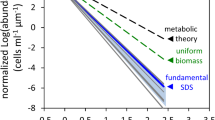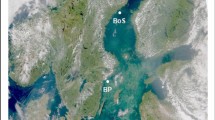Abstract
When traits affecting species interactions evolve rapidly, ecological dynamics can be altered while they occur. These eco-evolutionary dynamics have been documented repeatedly in laboratory and mesocosm experiments. We show here that they are also important for understanding community functioning in a natural ecosystem. Daphnia is a major planktonic consumer influencing seasonal plankton dynamics in many lakes. It is also sensitive to succession in its phytoplankton food, from edible algae in spring to relatively inedible cyanobacteria in summer. We show for Daphnia mendotae in Oneida Lake, New York, United States, that within-year ecological change in phytoplankton (from spring diatoms, cryptophytes and greens to summer cyanobacteria) resulted in consumers evolving increasing tolerance to cyanobacteria over time. This evolution fed back on ecological seasonal changes in population abundance of this major phytoplankton consumer. Oneida Lake is typical of mesotrophic lakes broadly, suggesting that eco-evolutionary consumer-resource dynamics is probably common.
This is a preview of subscription content, access via your institution
Access options
Access Nature and 54 other Nature Portfolio journals
Get Nature+, our best-value online-access subscription
$29.99 / 30 days
cancel any time
Subscribe to this journal
Receive 12 digital issues and online access to articles
$119.00 per year
only $9.92 per issue
Buy this article
- Purchase on Springer Link
- Instant access to full article PDF
Prices may be subject to local taxes which are calculated during checkout





Similar content being viewed by others
Data availability
The data underlying each of the figures and statistical analyses are freely available online at eCommons: Cornell University’s digital repository45 (https://doi.org/10.7298/pgzv-2736).
Code availability
R scripts for R-generated statistical analyses and figures are freely available online at eCommons: Cornell University’s digital repository45 (https://doi.org/10.7298/pgzv-2736).
References
Hendry, A. P. Eco-Evolutionary Dynamics (Princeton Univ. Press, 2017).
Schoener, T. W. The newest synthesis: understanding the interplay of evolutionary and ecological dynamics. Science 331, 426–429 (2011).
Hairston, N. G. Jr, Ellner, S. P., Geber, M. A., Yoshida, T. & Fox, J. A. Rapid evolution and the convergence of ecological and evolutionary time. Ecol. Lett. 8, 1114–1127 (2005).
Yoshida, T., Jones, L. E., Ellner, S. P., Fussmann, G. F. & Hairston, N. G. Jr. Rapid evolution drives ecological dynamics in a predator–prey system. Nature 424, 303–306 (2003).
Turcotte, M. M., Reznick, D. N. & Hare, J. D. Experimental assessment of the impact of rapid evolution on population dynamics. Evol. Ecol. Res. 13, 113–131 (2011).
Hiltunen, T., Hairston, N. G. Jr., Hooker, G., Jones, L. E. & Ellner, S. P. A newly discovered role of evolution in previously published consumer-resource dynamics. Ecol. Lett. 17, 915–923 (2014).
Bassar, R. D. et al. Local adaptation in Trinidadian guppies alters ecosystem processes. Proc. Natl Acad. Sci. USA 107, 3616–3621 (2010).
Agrawal, A. A., Johnson, M. T. J., Hastings, A. & Maron, J. L. A field experiment demonstrating plant life-history evolution and its eco-evolutionary feedback to seed predator populations. Am. Nat. 181, S35–S45 (2013).
Pantel, J. H., Duvivier, C. & De Meester, L. Rapid local adaptation mediates zooplankton community assembly in experimental mesocosms. Ecol. Lett. 18, 992–1000 (2015).
Lampert, W. Daphnia: Development of a Model Organism in Ecology and Evolution (International Ecology Institute, 2011).
Miner, B. E., De Meester, L., Pfrender, M. E., Lampert, W. & Hairston, N. G.Jr. Linking genes to communities and ecosystems: Daphnia as an ecogenomic model. Proc. R. Soc. B 279, 1873–1882 (2012).
Tessier, A. J. & Woodruff, P. Cryptic trophic cascade along a gradient of lake size. Ecology 83, 1263–1270 (2002).
Sterner, R. W. & Elser, J. J. Ecological Stoichiometry: The Biology of Elements from Molecules to the Biosphere (Princeton Univ. Press, 2002).
Rudstam, L. G., Lathrop, R. C. & Carpenter, S. R. The rise and fall of a dominant planktivore: direct and indirect effects on zooplankton. Ecology 74, 303–319 (1993).
Carpenter, S. R. et al. Regulation of lake primary productivity by food web structure. Ecology 68, 1863–1876 (1987).
Lampert, W. Laboratory studies on zooplankton–cyanobacteria interactions. N.Z. J. Mar. Freshwater Res. 21, 483–490 (1987).
Martin-Creuzburg, D., von Elert, E. & Hoffmann, K. H. Nutritional constraints at the cyanobacteria–Daphnia magna interface: the role of sterols. Limnol. Oceanogr. 53, 456–468 (2008).
Hairston, N. G.Jr. et al. Rapid evolution revealed by dormant eggs. Nature 401, 446 (1999).
Sarnelle, O. & Wilson, A. E. Local adaptation of Daphnia pulicaria to toxic cyanobacteria. Limnol. Oceanogr. 50, 1565–1570 (2005).
Chislock, M. F., Sarnelle, O., Olsen, B. K., Doster, E. & Wilson, A. E. Large effects of consumer offense on ecosystem structure and function. Ecology 94, 2375–2380 (2013).
Cáceres, C. E. et al. in Oneida Lake: L ong-term Dynamics of a Managed Ecosystem and its Fishery (eds Rudstam, L. G, Mills, E. L., Jackson, J. R. & Stewart, D. L.) 201–226 (American Fisheries Society, 2016).
Cáceres, C. E. Interspecific variation in the abundance, production, and emergence of Daphnia diapausing eggs. Ecology 79, 1699–1710 (1998).
Lampert, W. & Trubetskova, I. Juvenile growth rate as a measure of fitness in Daphnia. Funct. Ecol. 10, 631–635 (1996).
Sommer, U., Gliwicz, M., Lampert, W. & Duncan, A. The PEG-model of seasonal succession of planktonic events in fresh waters. Arch. Hydrobiol. 106, 433–471 (1986).
Sommer, U. et al. Beyond the plankton ecology group (PEG) model: mechanisms driving plankton succession. Annu. Rev. Ecol. Evol. Syst. 43, 429–448 (2012).
Idrisi, N., Mills, E. L. & Rudstam, L. G. in Oneida Lake: Long-term Dynamics of a Managed Ecosystem and its Fishery (eds Rudstam, L. G, Mills, E. L., Jackson, J. R. & Stewart, D. L.) 139–159 (American Fisheries Society, 2016).
Hairston, N. G.Jr. Zooplankton egg banks as biotic reservoirs in changing environments. Limnol. Oceanogr. 41, 1087–1092 (1996).
Chesson, P. Multispecies competition in variable environments. Theor. Popul. Biol. 45, 227–276 (1994).
Ellner, S. P., Snyder, R. E. & Adler, P. B. How to quantify the temporal storage effect using simulations instead of math. Ecol. Lett. 19, 1333–1342 (2016).
Ellner, S. P. & Hairston, N. G. Jr. Role of overlapping generations in maintaining genetic variation in a fluctuating environment. Am. Nat. 143, 403–417 (1994).
Hedrick, P. W. Genetic polymorphism in a temporally varying environment: effect of delayed germination or diapause. Heredity 75, 164–170 (1995).
Turelli, M., Schemske, D. W. & Bierzychudek, P. Stable two-allele polymorphisms maintained by fluctuating fitnesses and seed banks: protecting the blues in Linanthus parryae. Evolution 55, 1283–1298 (2001).
Hendry, A. P. & Kinnison, M. T. Perspective: the pace of modern life: measuring rates of contemporary evolution. Evolution 53, 1637–1653 (1999).
Messer, P. W., Ellner, S. P. & Hairston, N. G.Jr. Can population genetics adapt to rapid evolution? Trends Genet. 32, 408–418 (2016).
Rudstam, L. G., Mills, E. L., Jackson, J. R. & Stewart, D. J. in Oneida Lake: Long-term Dynamics of a Managed Ecosystem and its Fishery (eds Rudstam, L. G, Mills, E. L., Jackson, J. R. & Stewart, D. L.) 3–11 (American Fisheries Society, 2016).
Cuhel, R. L. &, Aguilar, C. in Oneida Lake: Long-term Dynamics of a Managed Ecosystem and its Fishery (eds Rudstam, L. G, Mills, E. L., Jackson, J. R. & Stewart, D. L.) 111–137 (American Fisheries Society, 2016).
Hairston, N. G.Jr. & Van Brunt, R. A. Diapause dynamics of two diaptomid copepod species in a large lake. Hydrobiologia 292, 209–218 (1994).
Hansen, A.-M. & Hairston, N. G. Jr. Food limitation in a wild cyclopoid copepod population: direct and indirect life history responses. Oecologia 115, 320–330 (1998).
Hairston, N. G.Jr., Hansen, A.-M. & Schaffner, W. R. The effect of diapause emergence on the seasonal dynamics of a zooplankton assemblage. Freshw. Biol. 45, 133–145 (2000).
Brede, N. et al. Microsatellite markers for European Daphnia. Mol. Ecol. Notes 6, 536–539 (2006).
Hotto, A. M., Satchwell, M. F., Berry, D. L., Gobler, C. J. & Boyer, G. L. Spatial and temporal diversity of microcystins and microcystin-producing genotypes in Oneida Lake, NY. Harmful Algae 7, 671–681 (2008).
Montero-Pau, J., Gómez, A. & Munoz, J. Application of an inexpensive and high-throughput genomic DNA extraction method for the molecular ecology of zooplanktonic diapausing eggs. Limnol. Oceanogr. Methods 6, 218–222 (2008).
Meirmans, P. C. & Van Tienderen, P. H. GENOTYPE and GENODIVE: two programs for the analysis of genetic diversity of asexual organisms. Mol. Ecol. Notes 4, 792–794 (2004).
R Core Team. R: A Language and Environment for Statistical Computing (R Foundation for Statistical Computing, 2017).
Schaffner, L. R. et al. Data from: Consumer-resource Dynamics is an Eco-Evolutionary Process in a Natural Plankton Community (Cornell Univ., 2019); https://doi.org/10.7298/pgzv-2736
Pielou, E. C. An Introduction to Mathematical Ecology (John Wiley & Sons, 1969).
Greeson, P. E. Limnology of Oneida Lake with Emphasis on Factors Contributing to Algal Blooms (U.S. Geological Survey, 1971).
Holm, S. A simple sequentially rejective multiple test procedure. Scand. J. Stat. 6, 65–70 (1979).
Acknowledgements
Sample preparation for microsatellite DNA sequencing was carried out by E. Keller and S. Bogdanowicz advised on interpretation of genotype data. J. Geyer, D. Oden and A. Wong helped in the laboratory and field. W. Lampert contributed insights to the JGR measure. P. McIntyre, R. Wilkins, K. Sirianni, L. Zarri, E. Larson and members of the Hairston–Flecker laboratory groups provided helpful comments on the manuscript. The research was supported by US National Science Foundation grant no. DEB-1256719 to N.G.H., S.P.E. and B.E.M., KU Leuven Research Fund grant no. C16/2017/02 to L.D.M., a Research Foundation–Flanders travel grant and Agency for Innovation by Science and Technology PhD fellowship to L.G. and by Doris Duke Foundation internship funding to E.F. The CBFS and New York State Department of Environmental Conservation supported field sampling and processing.
Author information
Authors and Affiliations
Contributions
B.E.M., S.P.E. and N.G.H. conceived the study. L.R.S., B.E.M. and N.G.H. designed the field sampling; E.F., L.R.S. and L.G.R. and his laboratory carried it out. L.R.S. and N.G.H. designed the laboratory experiment and L.R.S. carried it out. P.S. and his laboratory did the microsatellite DNA sequencing. B.E.M. and L.R.S. analysed the microsatellite data to calculate genotype frequencies. N.G.H., L.R.S., L.G., L.D.M and S.P.E. analysed the experimental results. The first draft was written by L.R.S. and N.G.H. All authors contributed to revisions of the manuscript.
Corresponding author
Ethics declarations
Competing interests
The authors declare no competing interests.
Additional information
Publisher’s note: Springer Nature remains neutral with regard to jurisdictional claims in published maps and institutional affiliations.
Supplementary Information
Supplementary Information
Supplementary Figs. 1–3 and Supplementary Table 1.
Rights and permissions
About this article
Cite this article
Schaffner, L.R., Govaert, L., De Meester, L. et al. Consumer-resource dynamics is an eco-evolutionary process in a natural plankton community. Nat Ecol Evol 3, 1351–1358 (2019). https://doi.org/10.1038/s41559-019-0960-9
Received:
Accepted:
Published:
Issue Date:
DOI: https://doi.org/10.1038/s41559-019-0960-9
This article is cited by
-
Local adaptation mediates direct and indirect effects of multiple stressors on consumer fitness
Oecologia (2022)
-
Grazing impacts on phytoplankton in South American water ecosystems: a synthesis
Hydrobiologia (2022)
-
Extensive standing genetic variation from a small number of founders enables rapid adaptation in Daphnia
Nature Communications (2021)
-
Reversed evolution of grazer resistance to cyanobacteria
Nature Communications (2021)
-
Self-perpetuating ecological–evolutionary dynamics in an agricultural host–parasite system
Nature Ecology & Evolution (2020)



